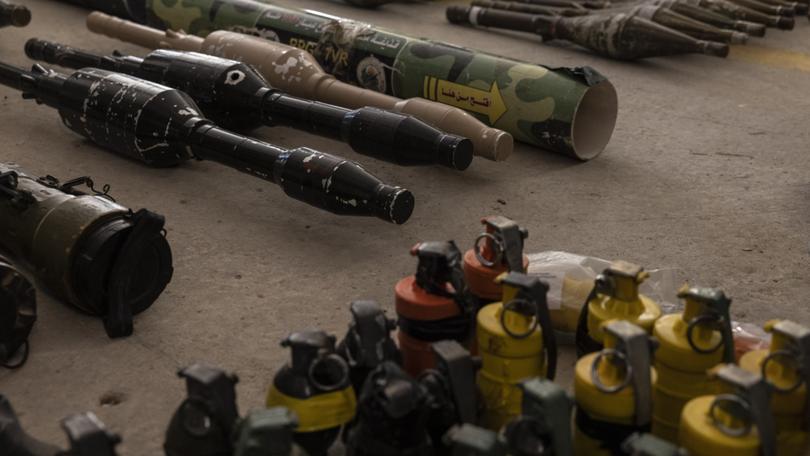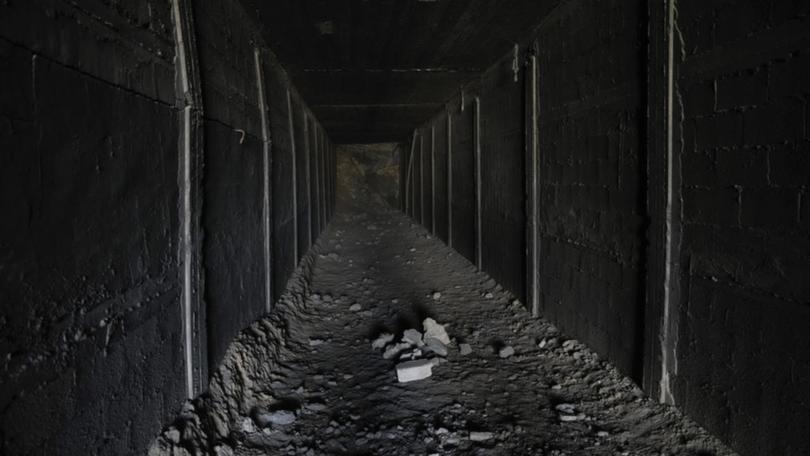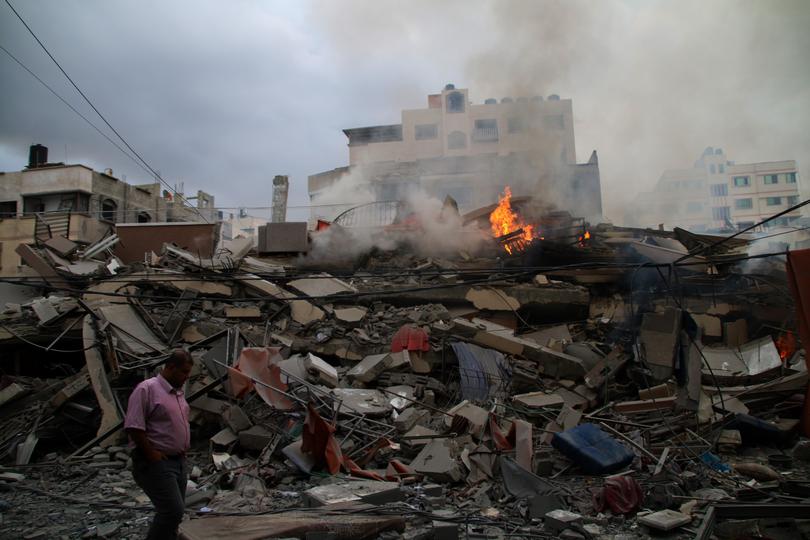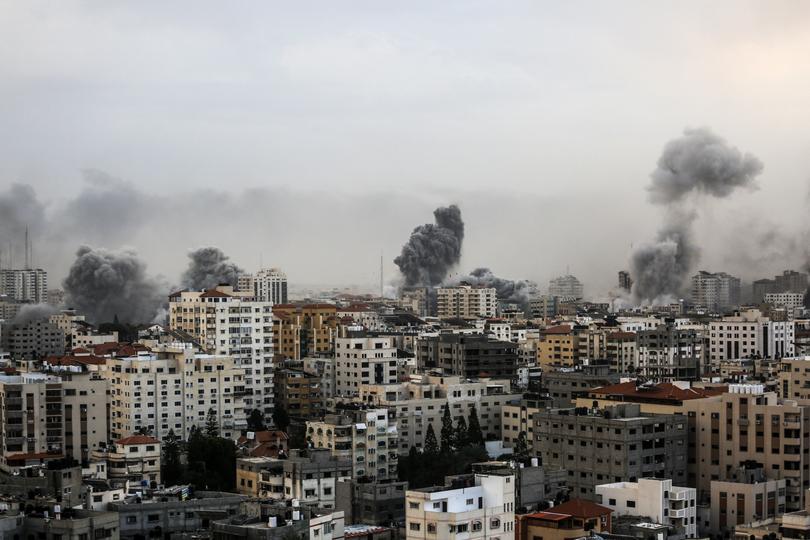THE WASHINGTON POST: Hamas built an underground war machine to ensure its own survival

AMMAN, Jordan - Six months before the October 7 attack, Hamas’s top leader in the Gaza Strip was meeting with visiting Palestinian businessmen in the enclave when he made a shocking disclosure. Hamas was planning something big, Yahya Sinwar told his guests.
“There’s going to be a surprise,” he said, according to one of the participants in the meeting, which has not been previously reported.
While offering no details, he intimated that preparations had long been underway in Gaza itself, within Hamas’s network of underground fortresses. Of the allies and partners assisting the effort, he mentioned only one.
Sign up to The Nightly's newsletters.
Get the first look at the digital newspaper, curated daily stories and breaking headlines delivered to your inbox.
By continuing you agree to our Terms and Privacy Policy.“God will help us,” he said.
Sinwar’s secret plan would reveal itself on a Jewish Sabbath morning one year ago as waves of attackers swarmed Israeli villages and military bases, killing about 1200 people and taking some 250 hostages.
But the nature of Sinwar’s preparations — how, exactly, the group armed itself for the assault while simultaneously engineering a sophisticated, multilayered defence against the inevitable Israeli military response — would become clear only gradually, in the weeks and months of heavy fighting that followed.
Evidence accumulated over the past year has brought new clarity to Hamas’s operational planning before Oct 7, revealing how and from where it obtained the means for both the attack itself and a carefully considered resistance phase that was designed to last up to 12 months.
It shows how, despite years of isolation within a densely populated strip of land the size of Philadelphia, Hamas acquired an astonishing arsenal of rockets, explosives and small arms, while constructing the financial and defensive networks that enabled Sinwar and his followers to hold out for months under a determined assault by one of the world’s most capable militaries.
Across Israel’s northern border, the Lebanese militia Hezbollah is in disarray after Israeli forces killed the group’s leader and decimated its command structure in a series of recent operations that revealed a deep penetration of the group by Israeli intelligence.
But a year after the Oct 7 attacks, Sinwar, who studied Israeli tactics during years in prison and later became notorious for brutally rooting out suspected Israeli collaborators, has not only survived but is already laying the groundwork for the group’s reemergence, according to Hamas officials interviewed by The Washington Post.
This article is based on interviews with more than two dozen Israeli, US and Arab military and intelligence analysts, many of whom spoke on the condition of anonymity to discuss sensitive intelligence assessments. The Post also interviewed current and former Hamas and Palestinian Authority officials, some of whom, like the businessman who met with Sinwar in the spring of 2023, spoke on the condition of anonymity for fear of reprisals.
The accounts describe how Hamas, under Sinwar’s leadership, became relentlessly focused on achieving self-sufficiency, including a capacity to produce its own weapons and explosives, and carry out elaborate operations involving thousands of participants, while maintaining complete secrecy.
The group relied on outsiders for money and advice. It raised tens of millions of dollars, some of it from Iran, but much of it siphoned from aid money, charitable contributions, tax revenue and — after October 7 — shareholder deposits stolen from Gazan banks.
Hamas commanders travelled to Tehran for training, Israel Defense Forces officials say, and made multiple trips to Lebanon, where Iran had established an operations room to coordinate military planning and share technical know-how.
But the Hamas that Sinwar built was no mere proxy group, officials and experts said. Mindful of Israel’s ability to cut off Gaza from the world, Hamas spent years perfecting a war machine that could make its own munitions, carry out operations without outside approval or even knowledge, and then allow its fighters to disappear inside an elaborate underground maze — a warren beneath the streets of the seaside enclave estimated to consist of hundreds of miles of interlinked, reinforced passages, rooms and bunkers.
Hamas’s tunnels are its greatest engineering feat and, to Sinwar, the key to its survival.
“We succeeded in making manufacturing factories underground,” Ghazi Hamad, a member of Hamas’s political bureau from Gaza, said in an interview with The Post, “because we knew that one day all the channels would be closed.”
Hamas today is, without question, a badly diminished force.
The group has lost its top civilian leader along with dozens of military commanders and an estimated 15,000 fighters, according to regional intelligence officials. Cash and weapons stockpiles are dwindling; swaths of the Strip lie in ruins; and at least 40,000 Palestinians have been killed, according to the Gaza Health Ministry, which does not distinguish between civilians and combatants but says the majority of the dead are women and children. Many of the group’s estimated 5700 tunnel shafts have been destroyed by Israeli bombs.
Yet Hamas fights on. The group’s capabilities and tactics, revealed over the past year, have repeatedly challenged the conventional thinking about Hamas that existed before October 7, 2023. They also raise new concerns about the organisation’s ability to reconstitute itself in Gaza or elsewhere.
Many analysts had believed that Hamas was heavily dependent on Iran and had smuggled in large shipments of Iranian-made rockets and missiles while making new ones in large underground factories. Yet a year later, IDF investigators in Gaza have turned up surprisingly few Iranian-made weapons, and no large-scale factories for mass assembly of rockets and missiles.
Instead, they mostly found small workshops where metalworkers with simple lathes turned scavenged pipes and agricultural chemicals into components for explosive projectiles to be lobbed into Israeli villages.
After the IDF’s May invasion of Gaza’s southernmost city, Rafah, an Israeli commander reported finding no new active smuggling tunnels leading into Egypt, as many experts had believed existed.
In the previous decade, when Gazans ran contraband through hundreds of tunnels along the border, Israeli forces would sometimes seal off the shafts with concrete, only to later discover that Hamas had drilled new passageways through the barriers. The group even tweaked rocket designs so that the components were small enough to fit through twists and turns in the reconfigured passageways.
Yet after the Rafah invasion, intelligence analysts concluded that most of Hamas’s supply of imported weapons and components had entered overland, in trucks and cars passing through border crossings controlled by Egypt and Israel. The rest arrived years ago, before Egypt destroyed thousands of underground passageways and created a mile-wide system of barriers along its border with Gaza.
But the biggest surprise, US and Israeli officials say, was the tunnels within Gaza.
Israeli war planners well understood the challenge IDF soldiers faced in trying to defeat a foe that could move fighters and supplies freely through underground passages. But the size, scale and complexity of the Gaza “metro,” as it came to be dubbed, far exceeded Israeli estimations.
IDF officials in interviews described their dismay after picking their way through bunkers 30 feet beneath Gaza’s streets, only to find shafts leading to deeper tunnels buried 120 feet underground.
“Their eyes were bulging,” said a former US counterterrorism official who visited Hamas-built tunnels as a guest of the IDF. “They had no idea of the labyrinth. Can you image 150 kilometres of tunnels? The reality was several times bigger.”

“We will come to you with endless rockets’”
In private conversations and in public speeches before October 7, Sinwar could not restrain himself from bragging about what his group had achieved. Outside Gaza, his words were mostly dismissed as empty boasts.
“We will come to you, God willing, in a roaring flood,” Sinwar warned Israelis at a rally for his supporters in Gaza on December 14, 2022.
“We will come to you with endless rockets, we will come to you in a limitless flood of soldiers, we will come to you with millions of our people, like the repeating tides.”
Sinwar, who had long dreamed of inflicting a savage blow that could disrupt the status quo with Israel, “made sure the money and material was there for many years,” said Abu Hamza, 33, a Hamas commander in the West Bank town of Jenin. Abu Hamza spoke on the condition that he be identified by his nom de guerre for security reasons.
“Hamas built really well for this thing,” Abu Hamza said. Inside the tunnels, Hamas was “hiding weapons and making their own,” while labouring to ensure that Hamas could withstand any Israeli counterstrike.
“In Gaza we were working day and night, day and night, 24 hours,” said Hamad, the member of the group’s political bureau.
“We prepared a lot, not for one year or two years.”
But even homemade weapons require parts that must be brought in from the outside. Hamad said getting components past the Israeli blockade was a constant challenge. Almost every facet of weapons production, from machine tools to agricultural chemicals for explosives, was either labelled for civilian use or hidden inside shipments of food or other everyday wares.
“We are in the situation that pressures us to do everything, and collect everything,” he said.
“We face a very dangerous country, with a lot of technology and weapons. It’s not easy to fight Israel. We knew this equation very well.”
Homemade arsenal
The Israeli response to October 7 began in earnest with a ground invasion three weeks later by an IDF force that eventually grew to 100,000 fighters. Within days, Israeli soldiers were venturing into Hamas’s tunnels, often with underground surveillance drones or bomb-sniffing dogs in the lead.
The images posted by the IDF in the weeks that followed offered the first glimpse into what Hamas had wrought underground. Among the initial findings were armouries filled with weapons — thousands of them, of every make and description: North Korean-made F-7 rocket-propelled grenades, Bulgarian rifles, Iranian 60mm mortars and Italian-designed TC/6 mines, a copy of which is produced in Egypt.
But IDF officials eventually concluded that up to 80 per cent of Hamas’s weapons were manufactured in Gaza, by the group itself. Among the homemade arms: antitank IEDs (improvised explosive devices), Claymore-type antipersonnel mines and thermobaric rocket-propelled grenades. Hamas — perhaps drawing inspiration from Islamic State fighters who used similar tactics in the 2017 battle for Mosul, Iraq — learned to modify small commercial drones to drop explosives, IDF officials said.
Hamas’s specialty is short- and medium-range rockets, such as the M-75, a copy of the Iranian-made Fajr-5, capable of striking targets as far away as Tel Aviv. More common is the Qassam, named after a legendary Syrian Arab nationalist from the 1920s and featuring a design developed by Hamas more than 20 years ago. Hamas weaponeers have assembled thousands of Qassams from steel water pipes, shaping the metal into rocket bodies using metal presses and lathes, and packing the warheads with hundreds of pounds of explosives made from sugar and potassium nitrate fertilizer.
While limited in range, a single Qassam costs only a few hundred dollars to make. The Israeli military’s Iron Dome anti-missile system shot down thousands of such rockets in the days after October 7, but at a cost of roughly US$50,000 per launch.
By January, the IDF had stumbled upon Hamas’s manufacturing hubs.
Israeli soldiers found dedicated fabrication centers for producing small arms, ammunition and explosives, and other workshops for crafting the cylindrical frames for rockets. Some of the production facilities consisted of interconnected underground chambers that formed crude assembly lines. These were not factories, in the traditional sense. But they served the purpose.
“They are essentially labs with lathes,” said Matthew Levitt, a former Treasury Department counterterrorism official who has studied Hamas and its tunnels for more than a decade.
The largest of the manufacturing hubs discovered up to now consisted of a complex of underground workshops and street-level warehouses, raided by IDF forces in January beneath a crowded district in Khan Younis, a city in central Gaza. Connected by tunnels, it amounted to a weapons assembly line that extended nearly half a mile, according to an IDF weapons expert who analyzed the site.
“There were many different capabilities within the same location,” the IDF official said.
“It was such a large operation, it took us about a week to process it.”
Secretly, and out of the view of satellite surveillance cameras, the group had created a “Hamas military industrial complex” that could produce a variety of cheap weapons in vast quantities, said Levitt, who now serves as the director of the Reinhard counterterrorism program for the Washington Institute of Near East Policy.
“Some of the weapons even had Hamas branding on them,” he said.
Cities beneath cities
The IDF had long known about the threat posed by tunnels.
After Hamas used cross-border tunnels to abduct Israeli soldier Gilad Shalit in 2006, Israeli forces deployed special sensors along the border that allowed them to hear, see and map efforts to dig new passages into Israeli territory.
Yet the size and complexity of the group’s tunnels within Gaza itself surprised everyone, including Israel’s vaunted intelligence services and their US counterparts.
“Nobody understood how extensive the tunnels were, or that there were so many different types of tunnels,” said Dana Stroul, the deputy assistant secretary of defence for the Middle East during the first three years of the Biden administration.
Echoing a common assessment among US and Israeli military officials, Stroul said the failure to grasp the many dimensions of Hamas’s most important strategic asset was “part of the intelligence failure” of Ocober 7, and one that has not yet been fully reckoned with.
Fighting an enemy that can move horizontally and vertically, through a battlefield situated in heavily populated urban terrain, posed a formidable military challenge, she said.
“I don’t know that any modern military has faced the complexity of the battlefield that the IDF faced in Gaza,” she said.
The tunnels served to hide weapons production, according to Israeli, US and Arab analysts, but they also served as a communications network, supply depot, highway system, logistics pipeline, bomb shelter and field hospital, officials said.
Hidden tunnel shafts were used as staging grounds for ambushes.
Underground living quarters became command centres and detention facilities for Israeli hostages.
Costing, at minimum, hundreds of millions of dollars — money that Hamas diverted from humanitarian and economic development projects intended to improve the lives of ordinary Gazans — the tunnel system by October 7 extended more than 300 miles, longer than the New York City subway, or about the distance from Tel Aviv to southern Turkey.
The IDF acknowledges there is no practical way to destroy the entire system.
The IDF eventually became adept at fighting underground. But Major General Dan Goldfus, an Israeli commander dubbed by local media as the IDF’s “tunnel destroyer,” said his forces initially faced a steep learning curve.
“All our definitions of tunnel shafts, tactical tunnels, strategic tunnels — none of that applies there,” Goldfus told the Hebrew-language newspaper Israel Hayom in August.
“It’s all one large network; you can enter it at the [northern] Erez Crossing and emerge in Rafah [on the Egyptian border]. Everything there is connected to everything.”
Goldfus described a moment of wonder in February when the IDF arrived at Sinwar’s hastily vacated underground command center, a suite of well-appointed bunkers buried deep beneath the streets of Khan Younis.
“We reached senior officials’ compounds and we studied this infrastructure … this center of strength, its importance,” Goldfus told the newspaper. “It slowly became revealed to us before our eyes. And when I understood it - what can I say, hats off.”
Surviving the siege, eyeing a comeback

By the day of the October 7 assault, Hamas’s well-trained military wing numbered about 35,000, including a vanguard of 6000 shock troops who burst into Israel early that morning for the attack the group dubbed Operation al-Aqsa Flood.
Hamad, the political bureau member, said the idea was to shake Israel to its core and force its leaders to end the siege on Gaza, halt settler expansion in the West Bank and curtail raids on the al-Aqsa Mosque, which sits atop Jerusalem’s Temple Mount, known in Islam as the Noble Sanctuary and revered by both Muslims and Jews.
He said he was not aware of October 7 planning in advance.
But Sinwar, Hamad said, also understood that Israel would respond with devastating force. Much of the planning and preparation in the years preceding the attack was devoted to ensuring that Hamas would not only survive the blow but also quickly recover so it could strike again.
The tunnels, amply stocked with provisions and weapons to last many months, would play a key role. But so would Hamas’s reserves of cash.
Hamas is believed to have socked away hundreds of millions of dollars in cash and cryptocurrencies before October 7, much of it from tax revenue collected from Gazans as well as financial aid given by Qatar — with the tacit approval of Israeli leaders — in recent years to keep the enclave’s economy from collapsing.
Hamas has used the cash over the past year to pay fighters in the group’s military wing, who Hamad said are still being “looked after,” even as the roughly 2 million civilians in Gaza have been forced into destitution.
The money has also enabled Hamas to retain a functioning public sector to meet the basic needs of Gazans, the officials said.
The group’s payroll includes 50,000 workers, including teachers, doctors, sanitation crews and more. Whatever money is left serves as a vital lifeline for Gazans struggling to feed their families at a time when many businesses and shops have been shuttered or destroyed.
Hamas regularly announces collection points and times for aid recipients, with new locations posted every month.
“I don’t know where the money comes from,” said an employee of the Gaza Justice Ministry.
“What I care about now is finding something to satisfy my two children’s hunger.”

Yet a year into the conflict, the tap appears to be finally running dry. Beginning in the spring, many Gazan workers began drawing only half their normal salaries, when they were paid at all.
With Israel’s unrelenting assault and a dearth of humanitarian trucks bearing food and other necessities reaching Gaza, Hamas may be reaching a tipping point, at least with regard to its supply of money and other vital resources, say analysts.
While Hamas was prepared for an extended siege, a year of IDF operations in Gaza — combined with stricter controls by Israelis at border crossings — have nearly drained Hamas’s coffers, officials said. Hamad maintains that Hamas still has “channels” to ensure cash flow into Gaza, but he declined to elaborate.
Still, one of Hamas’s key assets remains available to the group with a nearly inexhaustible supply. Analysts say Gaza’s devastation is spurring recruitment, driving legions of embittered or desperate youths into the arms of Hamas.
“There is no shortage of young volunteers,” a senior Arab intelligence official said. “Perhaps they are not as well trained, but they will help Hamas make up for its losses. These are the people who have lost families, and they have one motive: revenge.”
Hamas, still in survival mode, appears already to be shifting to a new phase of conflict that could more easily harness the energy of its newest members.
Social media postings by Hamas’s military wing, the al-Qassam Brigades, have begun to promote the tactics of an insurgency, such as bombings using IEDs.
One illustration, titled “The Hunting,” depicts three Israeli soldiers approaching a pair of mines. A Hamas operative in the foreground extends his hand to touch the remote-control trigger.
“What is hidden,” it warns, “is immense.”
© 2024 , The Washington Post
